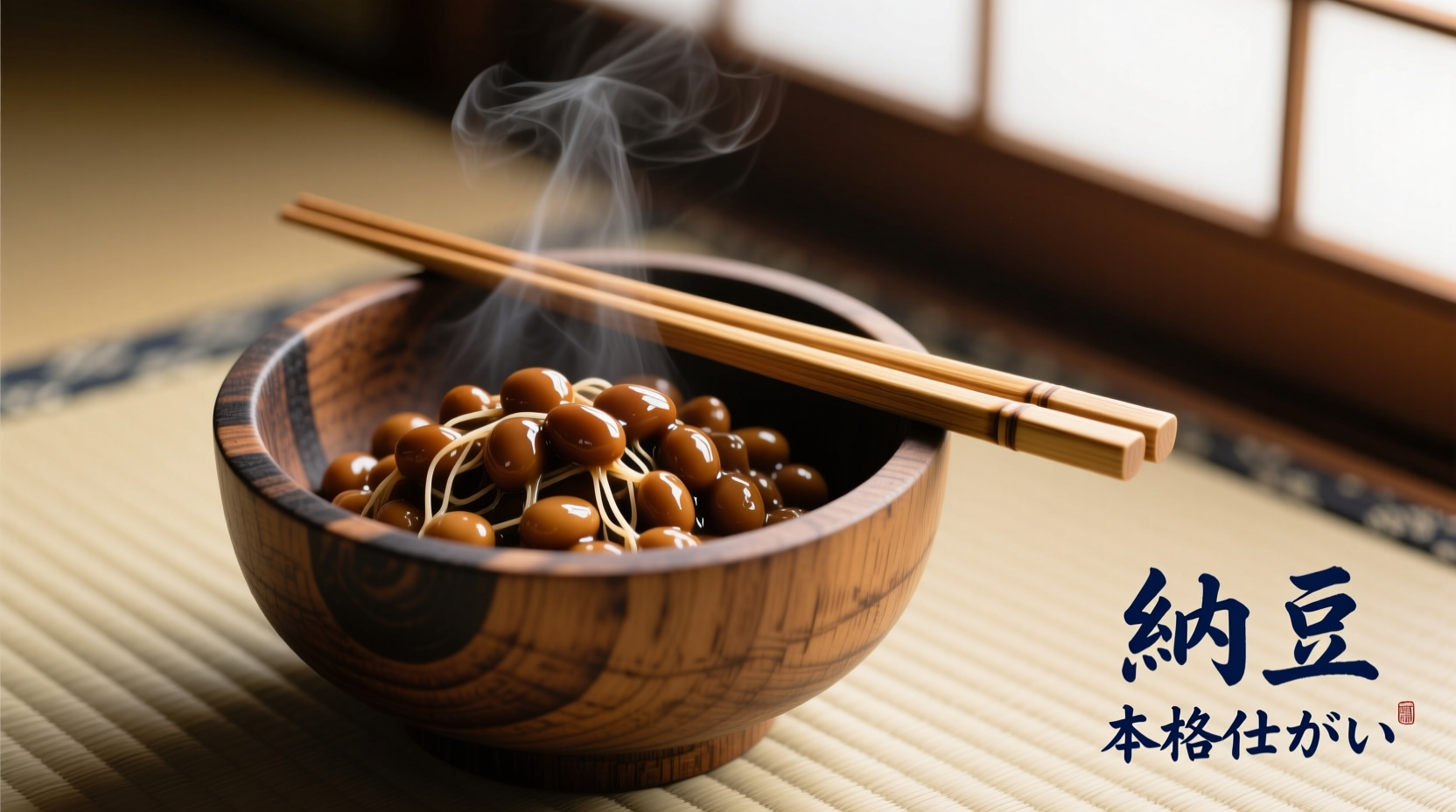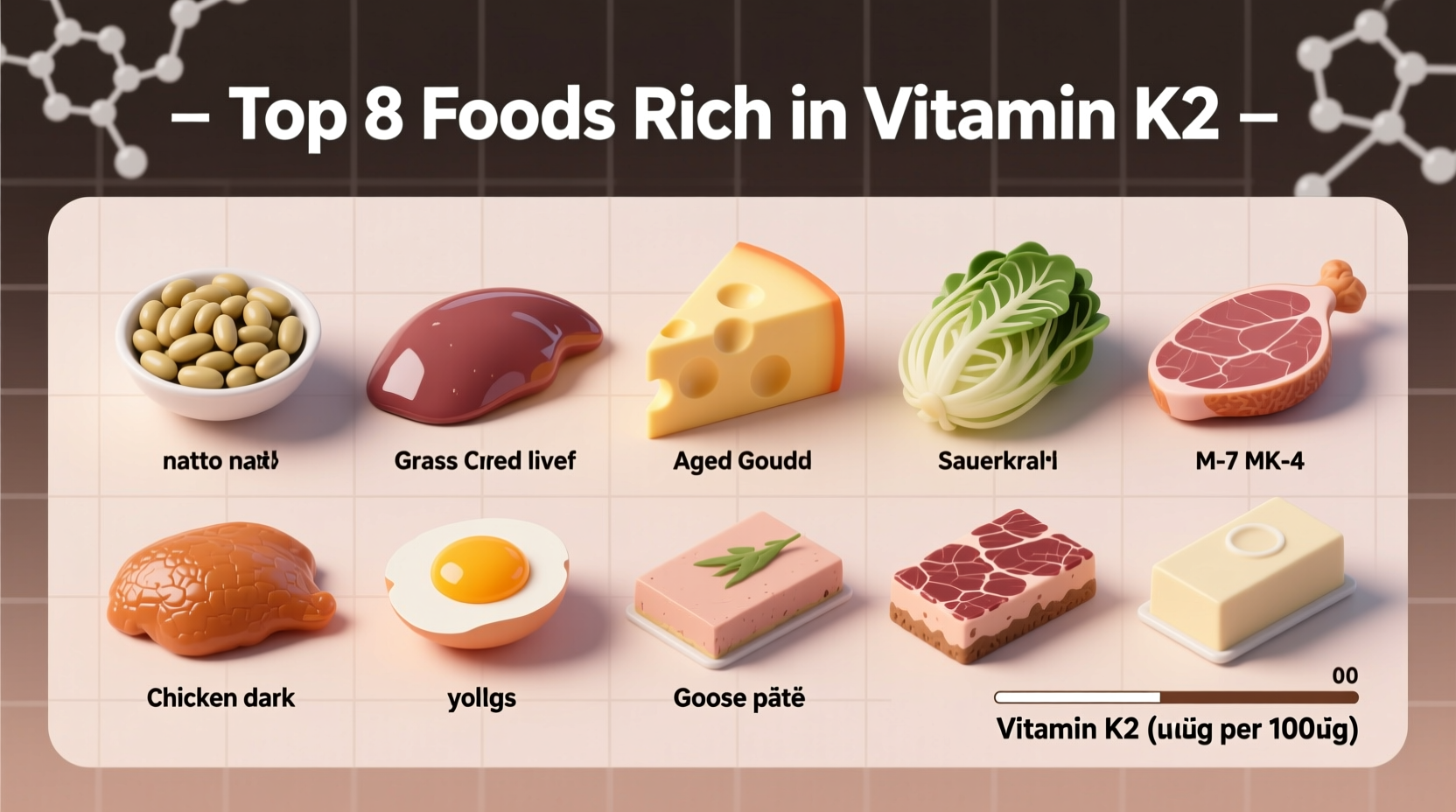The top foods highest in vitamin K2 are natto (fermented soybeans) with 850-1,000 mcg per 100g serving, followed by goose liver pâté (369 mcg), certain hard cheeses like Gouda (50-80 mcg), and egg yolks from pasture-raised chickens (32 mcg). Unlike vitamin K1 found in leafy greens, K2 (specifically MK-7 and MK-4 forms) plays crucial roles in bone and cardiovascular health through proper calcium regulation.
Discover exactly which foods deliver the most vitamin K2, how much you actually need, and practical ways to incorporate these nutrient-dense options into your daily meals. This comprehensive guide cuts through the confusion about vitamin K2 sources with scientifically verified information you can trust.
Why Vitamin K2 Matters More Than You Think
Vitamin K2 isn't just another nutrient—it's the missing link in calcium metabolism that determines whether calcium strengthens your bones or clogs your arteries. Research from the Rotterdam Study, tracking 4,800 participants over seven years, found those with the highest K2 intake had 50% reduced risk of arterial calcification and cardiovascular death compared to those with the lowest intake.
Unlike vitamin K1 (abundant in kale and spinach), which primarily supports blood clotting, vitamin K2 activates proteins that direct calcium to your bones and teeth while preventing deposits in soft tissues. This distinction explains why populations consuming traditional diets rich in K2—like the Japanese with natto or Europeans with fermented dairy—demonstrate remarkable bone density and cardiovascular health despite lower calcium intakes.
The Vitamin K2 Food Hierarchy: Highest to Lowest
Category 1: Exceptional K2 Powerhouses (200+ mcg per serving)
Natto stands alone in this category, containing 850-1,000 mcg of MK-7 per 100g serving—the most bioavailable form of K2. This traditional Japanese fermented soybean dish produces K2 through bacterial fermentation (Bacillus subtilis). One standard 50g serving delivers 400-500 mcg, exceeding the recommended daily intake by 300-400%.
While natto's sticky texture and strong flavor challenge Western palates, its health benefits are unmatched. A 2020 clinical trial published in Nutrients demonstrated that daily natto consumption increased circulating MK-7 levels by 600% within four weeks, significantly improving bone mineral density in postmenopausal women.
Category 2: Significant K2 Sources (35-200 mcg per serving)
| Food Source | K2 Content (mcg per 100g) | Primary K2 Form | Practical Serving Size |
|---|---|---|---|
| Goose liver pâté | 369 | MK-4 | 28g (1 oz) = 103 mcg |
| Gouda cheese (aged) | 75-85 | MK-8, MK-9 | 28g (1 oz) = 21-24 mcg |
| Brie cheese | 50-60 | MK-8, MK-9 | 28g (1 oz) = 14-17 mcg |
| Egg yolks (pasture-raised) | 32 | MK-4 | 1 large yolk = 8-10 mcg |
Notice the critical distinction between conventional and pasture-raised animal products. Research from Weston A. Price Foundation shows pasture-raised eggs contain 3-6 times more K2 than standard supermarket eggs due to chickens' natural diets rich in K2-producing bacteria.
Category 3: Moderate K2 Contributors (5-35 mcg per serving)
This category includes butter from grass-fed cows (15 mcg/100g), chicken liver (14 mcg/100g), and certain traditional fermented foods like sauerkraut (when properly fermented with K2-producing bacteria). The K2 content in these foods varies significantly based on animal diet and fermentation methods.
For example, standard supermarket sauerkraut typically contains negligible K2 because modern production skips the traditional 6-8 week fermentation period required for K2 production. Authentic lacto-fermented sauerkraut from specialty producers can provide 5-10 mcg per serving, but always check production methods.
K2 vs K1: Understanding the Critical Differences
Many confuse vitamin K1 and K2, but their biological roles differ substantially:
| Characteristic | Vitamin K1 (Phylloquinone) | Vitamin K2 (Menaquinones) |
|---|---|---|
| Primary Food Sources | Leafy green vegetables (kale, spinach) | Fermented foods, animal products |
| Main Biological Role | Blood clotting | Calcium regulation in bones/arteries |
| Half-life in Body | 1.5-3 hours | MK-4: 2 hours; MK-7: 72-96 hours |
| Conversion Efficiency | N/A | Humans convert K1 to K2 poorly (max 5% efficiency) |
This comparison explains why eating spinach won't provide meaningful K2 benefits. The human body converts K1 to K2 with less than 5% efficiency according to research published in the American Journal of Clinical Nutrition. To optimize K2 status, you must consume K2 directly from food sources.
Practical Integration: Adding K2 to Your Daily Routine
Transforming this knowledge into daily practice requires strategic planning. Here's how to effectively incorporate K2-rich foods:
For Natto Newcomers
If natto's distinctive flavor challenges your palate, try these approaches:
- Mix small portions (10-15g) into miso soup to mellow the flavor
- Add to scrambled eggs with scallions and sesame oil
- Combine with avocado for creaminess that balances the texture
Gradually increase portions over 2-3 weeks as your taste buds adapt. Studies show most people develop a preference for natto within one month of regular consumption.
Daily K2 Meal Framework
Create a sustainable K2 intake pattern with this simple framework:
- Breakfast: 2 pasture-raised eggs with grass-fed butter (15-20 mcg K2)
- Lunch: Salad with Gouda cheese (30-40 mcg K2)
- Dinner: Chicken liver pâté on sourdough or natto portion (50-500 mcg K2)
This pattern delivers 95-560 mcg of K2 daily—well within the optimal range of 100-200 mcg established by the European Food Safety Authority for cardiovascular and bone health benefits.
Context Matters: When Food Sources Fall Short
While food sources should be your primary K2 strategy, certain situations require additional consideration:
- Antibiotic users: Gut microbiome disruption from antibiotics significantly reduces natural K2 production. Increase fermented food intake during and after treatment.
- Strict vegetarians: Without animal products, your only substantial K2 source is natto. Consider regular testing to monitor K2 status.
- Those with fat malabsorption: Conditions like Crohn's disease or pancreatic insufficiency impair K2 absorption. Consult a healthcare provider about water-soluble K2 supplements.
The National Institutes of Health Office of Dietary Supplements notes that vitamin K2 absorption depends on adequate dietary fat—always consume K2 foods with healthy fats like olive oil or avocado to maximize uptake.
Debunking Common K2 Myths
Navigating vitamin K2 information requires separating fact from fiction:
Myth: "All fermented foods contain significant K2."
Reality: Only foods fermented with specific K2-producing bacteria (like Bacillus subtilis in natto) generate meaningful K2. Most commercial yogurts and kefirs contain negligible amounts.
Myth: "Grass-fed dairy always has more K2."
Reality: While grass-fed dairy generally contains more K2 than conventional, the difference varies by season and specific farming practices. Winter milk from grass-fed cows may have similar K2 levels to conventional summer milk.

Measuring Your K2 Status: What Most People Miss
Unlike many nutrients, vitamin K2 status isn't routinely tested in standard blood work. The most accurate assessment comes from measuring uncarboxylated osteocalcin (ucOC)—a protein that remains inactive without sufficient K2.
Research from the University of Maastricht shows that 60-80% of Western populations have ucOC levels indicating suboptimal K2 status. If you experience frequent muscle cramps, easy bruising, or have osteoporosis risk factors, consider discussing a ucOC test with your healthcare provider.
For most people, consistently incorporating the K2-rich foods outlined in this guide will optimize your status without supplementation. Start with one high-K2 food daily and gradually build your intake pattern based on personal tolerance and preferences.











 浙公网安备
33010002000092号
浙公网安备
33010002000092号 浙B2-20120091-4
浙B2-20120091-4